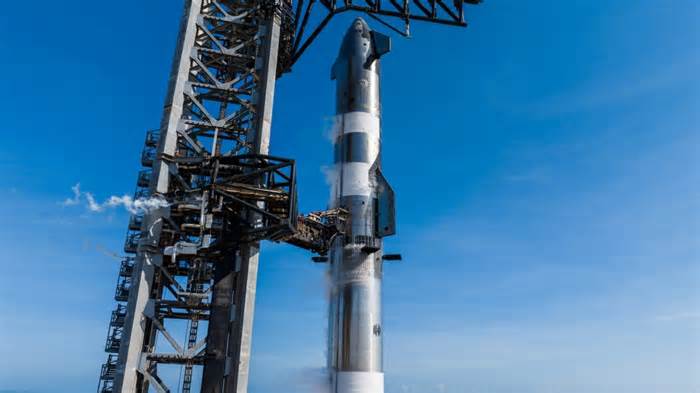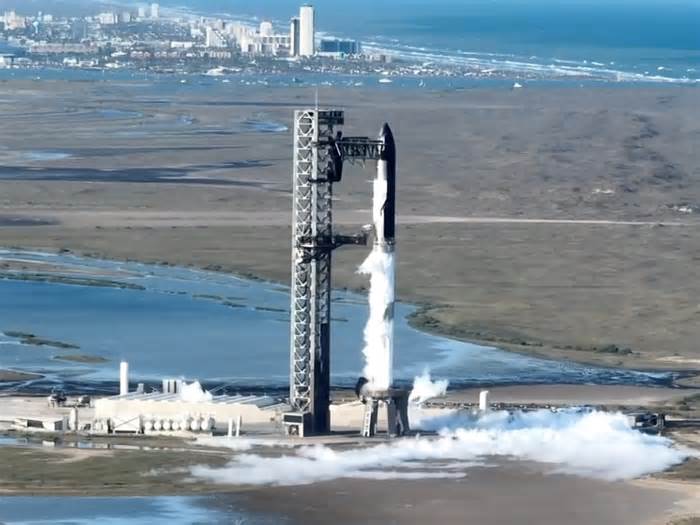
SpaceX will try some new tricks on Starship’s sixth test flight
- by Ars Technica
- Nov 19, 2024
- 0 Comments
- 0 Likes Flag 0 Of 5

Credit: SpaceX
The second change SpaceX will introduce on this test flight involves the vehicle's heat shield. These modifications will allow engineers to gather data before future attempts to return Starship to land at SpaceX's Starbase launch site in South Texas.
Perhaps as soon as next year, SpaceX wants to bring Starship back to Starbase to be caught by mechanical arms on the launch tower, similar to the way the company recovered the rocket's Super Heavy booster for the first time last month. Eventually, SpaceX aims to rapidly reuse Super Heavy boosters and Starships.
"The flight test will assess new secondary thermal protection materials and will have entire sections of heat shield tiles removed on either side of the ship in locations being studied for catch-enabling hardware on future vehicles," SpaceX wrote on its mission overview page.
SpaceX installed catch fittings on the Super Heavy booster to allow it to be captured by the launch tower's catch arms. The ship will need similar fittings jutting out from its heat shield.
"The ship also will intentionally fly at a higher angle of attack in the final phase of descent, purposefully stressing the limits of flap control to gain data on future landing profiles," SpaceX said.
By the light of day
One other significant difference with Tuesday's test flight will be the time of launch. Starship's 30-minute launch window opens at 4 pm CST (21:00 UTC), whereas all five of the rocket's previous test flights took off in the morning.
This change means Starship will reenter the atmosphere in daylight, providing better conditions for visual observations, SpaceX said. Previous Starship descents over the Indian Ocean occurred at night. The most recent test flight last month ended with an on-target soft splashdown.
This graphic, created by SpaceX, illustrates the maneuvers the Super Heavy booster and Starship upper stage will perform on Flight 6.
Credit:
SpaceX
The rest of Starship's flight profile will mimic the previous launch. The Super Heavy booster's 33 liquid-fueled Raptor engines will propel the 397-foot-tall (121-meter) stainless steel launch vehicle off the pad with more than 16 million pounds of thrust, twice the power generated by NASA's Apollo-era Saturn V rocket.
Heading east from Starbase, the rocket will gulp more than 40,000 pounds of methane and liquid oxygen propellants every second. It will exceed the speed of sound after about one minute and then rocket through the stratosphere before shutting down most of the booster's 33 engines in preparation for staging.
The Super Heavy booster will separate from the ship around 2 minutes and 39 seconds after liftoff, just as six Raptor engines ignite on the Starship upper stage. After this "hot-staging" maneuver, the booster will flip around to fly tail first, then fire 13 of its engines to reverse course and thrust itself back toward Starbase at supersonic speed.
If all goes according to plan, the booster will slow its dive toward the ground with another burn of its Raptor engines. This final landing burn should carefully guide the booster in between the launch tower's arms as they close for the catch.
Remarkably, SpaceX succeeded in catching the Super Heavy booster on its first try last month, but there was room for improvement. For example, a piece of stainless steel metal from one of the booster's chines,
or small aerodynamic protuberances, stripped away from the rocket during its descent.
"Hardware upgrades for this flight add additional redundancy to booster propulsion systems, increase structural strength at key areas, and shorten the timeline to offload propellants from the booster following a successful catch," SpaceX said. "Mission designers also updated software controls and commit criteria for the booster’s launch and return."
In space, Starship will coast about a third of the way around the world before attempting the Raptor engine relight about 38 minutes into the flight. After this short burn, the ship will reorient itself to point its heat shield into the flow of super-heated plasma for reentry.
The flight should end about 65 minutes after launch, when the ship will maneuver from a belly-down orientation to a vertical position. Its Raptor engines will ignite one more time to put on the brakes for a controlled splashdown.
A turning point for Starship
This demo mission, if successful, will transition SpaceX's mega-rocket from an early-stage experimental program into something more mature. This is the last flight of the first-generation version of Starship, known as V1, and it comes five weeks after the most recent test flight.
SpaceX seeks to fly Starships as many as 25 times next year, so cutting down the turnaround time between flights is fundamental to the company's plans. Making Starship capable of sustained orbital operations
—something the in-space engine relight should enable
—is a prerequisite for launching Starlink satellites or refueling Starships in orbit.
Launching Starlinks on Starships is important for SpaceX to expand its global broadband network with larger, more powerful satellites too big to fit on the Falcon 9 rocket. And in-orbit refueling is required to support the ambitions of NASA and SpaceX to send Starships to the Moon and Mars, first with cargo and then with people.
Starship V2, which will debut on the seventh test flight, has larger propellant tanks, an upgraded heat shield, and redesigned forward flaps. It will be slightly taller than Starship V1.
President-elect Donald Trump, who SpaceX founder Elon Musk supported in this year's election, plans to travel to South Texas to witness Tuesday's launch, according to multiple media reports citing sources familiar with Trump's schedule.
In his victory speech on election night, Trump veered into the topic of Starship for several minutes, recalling the experience of watching the first catch of the Super Heavy booster last month. "It was a beautiful thing to see," Trump said.
Now, Musk is co-chairing Trump's Department of Government Efficiency chartered to reduce wasteful government spending. Starship, among other SpaceX programs, will likely become big winners as the Trump administration develops its space policy.
Please first to comment
Related Post
Stay Connected
Tweets by elonmuskTo get the latest tweets please make sure you are logged in on X on this browser.
Sponsored
Popular Post
Tesla: Buy This Dip, Energy Growth And Margin Recovery Are Vastly Underappreciated
28 ViewsJul 29 ,2024






 Energy
Energy



















